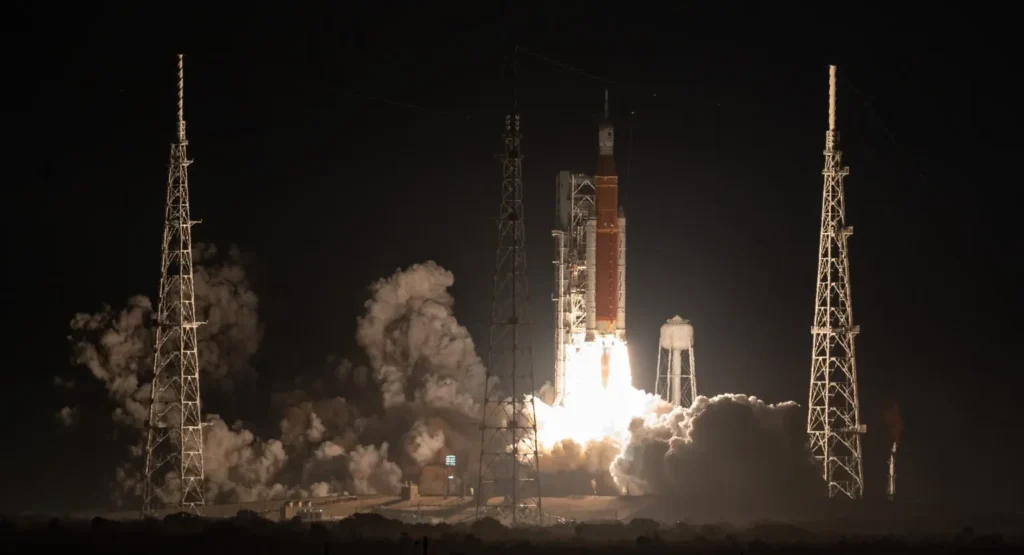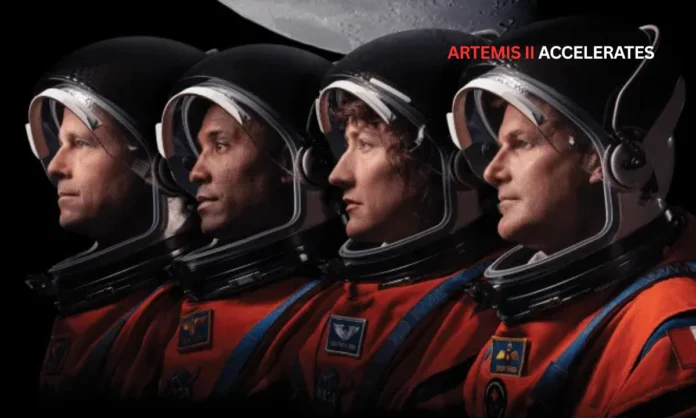Key Highlights:
- NASA officials confirmed Artemis II could potentially launch as early as February 5, 2026, pending final safety reviews and hardware validation
- The historic 10-day mission will carry four astronauts around the Moon for the first time in over 50 years, marking humanity’s return to deep space exploration
- Mission timeline includes five-day launch windows monthly from February through April 2026, with crew safety remaining the absolute priority
Initial Overview
NASA‘s ambitious Artemis II mission stands poised to accelerate humanity’s return to lunar exploration, with agency officials revealing the potential for a February 2026 launch during a September 24, 2025 press briefing at Johnson Space Center. The Artemis II mission represents a critical milestone in NASA’s broader Moon-to-Mars exploration campaign, carrying four astronauts on a free-return trajectory around the Moon aboard the Orion spacecraft. This announcement signals renewed momentum for the Artemis program, which has faced significant delays and budget pressures while maintaining its commitment to establishing sustainable lunar presence.
LIVE: Hear from the astronauts flying aboard the Artemis II test flight — the first crewed Artemis mission — in early 2026.
— NASA (@NASA) September 24, 2025
Their ~10-day mission will launch from @NASAKennedy in Florida, fly around the Moon, and splash down in the Pacific Ocean. https://t.co/qdWyUFD2aE
Artemis II mission planning has progressed steadily through 2025, with NASA’s Space Launch System rocket and Orion spacecraft assembly advancing at Kennedy Space Center. The mission timeline acceleration from the official April 2026 deadline to the potential February launch window demonstrates NASA’s confidence in overcoming previous technical challenges that affected the Artemis I flight.

NASA Artemis Program Mission Timeline showing the acceleration of Artemis II launch from April to February 2026
Artemis II Mission Architecture and Crew
- Mission Duration: The 10-day Artemis II flight will utilize a free-return trajectory, sending astronauts beyond the Moon at distances exceeding 9,200 kilometers from the lunar surface
- International Crew: Commander Reid Wiseman and Pilot Victor Glover from NASA join Mission Specialists Christina Koch (NASA) and Jeremy Hansen (Canadian Space Agency)
The Artemis II mission architecture leverages NASA’s most powerful rocket system ever built, combining the Space Launch System with the Orion Multi-Purpose Crew Vehicle. The mission profile involves launching the crew into Earth orbit, followed by a trans-lunar injection that will propel Artemis II astronauts farther from Earth than any humans have traveled since Apollo 17 in 1972. The Artemis II trajectory design ensures crew safety through its free-return path, allowing natural gravitational forces to bring the spacecraft back to Earth without requiring additional propulsion burns.

Space Launch System specifications include 8.8 million pounds of thrust at liftoff, generated by four RS-25 engines and two solid rocket boosters derived from Space Shuttle technology. The Artemis II crew will occupy the Orion spacecraft throughout their journey, with the capsule’s European Service Module providing life support, propulsion, and power generation capabilities during the 10-day mission duration. NASA engineers have addressed previous concerns identified during the uncrewed Artemis I flight, including heat shield performance and hydrogen fueling procedures that delayed the Artemis program timeline.
The multinational Artemis II crew brings extensive spaceflight experience, with Commander Reid Wiseman serving as NASA’s former Chief Astronaut and Pilot Victor Glover completing 168 days aboard the International Space Station. Mission Specialist Christina Koch holds the record for the longest single spaceflight by a woman, while Canadian astronaut Jeremy Hansen will become the first non-American to travel to lunar vicinity.
Technical Systems and Launch Preparations
- Assembly Progress: NASA expects to unveil the fully assembled Artemis II launch stack by October 2025, with final integration of crew module components completing in coming weeks
- Launch Infrastructure: All Artemis II launches will occur from Launch Complex 39B at Kennedy Space Center, utilizing ground systems specifically designed for deep space missions
The Artemis II mission depends on seamless integration between multiple complex systems, beginning with the Space Launch System’s Block 1 configuration featuring the Interim Cryogenic Propulsion Stage. Launch preparations include extensive testing of the Orion spacecraft’s life support systems, navigation computers, and communication arrays that will maintain contact with Mission Control throughout the lunar journey. The Artemis program utilizes launch escape systems designed to protect crew members during the most dangerous phases of flight, including tower-mounted solid rocket motors capable of pulling Orion away from a malfunctioning SLS rocket.
Ground systems supporting Artemis II launches have undergone significant upgrades since the Space Shuttle era, including new mobile launcher platforms and updated propellant loading procedures. NASA’s Exploration Ground Systems program received $758.8 million in fiscal year 2025 funding to ensure launch infrastructure readiness for the Artemis II timeline. The Kennedy Space Center modifications include environmental control systems for the Orion spacecraft, updated crew access arms, and emergency egress systems designed specifically for deep space mission requirements.
Mission Control capabilities have expanded to support Artemis II operations during the 10-day flight duration, with tracking stations positioned globally to maintain continuous communication with the lunar-bound crew. The Artemis II flight plan includes multiple trajectory correction opportunities and contingency procedures designed to address potential system failures while maintaining crew safety as the primary objective.
Budget Allocations and Program Sustainability
- Current Funding: NASA’s fiscal year 2025 budget allocates $7.8 billion specifically for Artemis program activities, supporting missions II through XII
- Long-term Investment: The total Artemis program cost through 2025 reaches approximately $93 billion, according to NASA’s Office of Inspector General estimates

NASA Artemis Program Budget Allocation for Fiscal Year 2025 ($7.8 billion total)
The Artemis program represents NASA’s largest financial commitment to human spaceflight since the Apollo era, with substantial budget allocations ensuring mission continuity through the decade. NASA’s fiscal year 2025 budget provides $4.2 billion for Moon to Mars Transportation Systems, including $1.0 billion for Orion spacecraft construction and $2.4 billion for Space Launch System development. Additional Artemis II funding supports $3.2 billion in Moon to Mars Lunar System Development, covering Human Landing System contracts, Gateway space station construction, and next-generation spacesuits.
Congressional appropriations for the Artemis program have faced political challenges, with lawmakers mandating continued funding for SLS and Orion programs at historical levels despite NASA proposals to shift resources toward future mission components. The House Appropriations Committee’s fiscal year 2025 recommendations include $1.339 billion for Orion spacecraft development and $2.6 billion for Space Launch System operations, exceeding NASA’s original budget requests. These funding increases demonstrate Congressional commitment to maintaining Artemis II schedule integrity while supporting broader program objectives.
President Trump’s “One Big Beautiful Bill” signed in July 2025 provided additional $9.9 billion in Artemis program funding extending through 2032, ensuring financial stability for missions beyond Artemis III. This supplemental appropriation includes specific allocations for SLS rocket production, Orion spacecraft manufacturing, and International Space Station operations that support Artemis program training requirements. The extended funding timeline allows NASA to maintain consistent contractor relationships and workforce development essential for Artemis II mission success.
Closing Assessment
The Artemis II mission timeline acceleration to February 2026 represents a significant achievement for NASA’s lunar exploration strategy, demonstrating the agency’s ability to overcome technical challenges while maintaining rigorous safety standards. Mission success depends on continued collaboration between NASA, international partners, and commercial contractors working toward the common goal of sustainable lunar exploration. The Artemis II crew’s historic journey will establish operational procedures and validate technologies essential for subsequent lunar landing missions, including the planned Artemis III surface operations in 2027.
NASA’s commitment to crew safety remains paramount throughout Artemis II preparations, with agency officials emphasizing that launch timing will ultimately depend on completing all necessary safety reviews and system validations. The mission’s success will pave the way for regular crewed flights to lunar orbit, supporting the construction of Gateway space station and preparation for Mars exploration missions in the 2030s. As humanity prepares to return to deep space for the first time in over five decades, the Artemis II mission represents both a tribute to past achievements and a foundation for future exploration beyond Earth.


